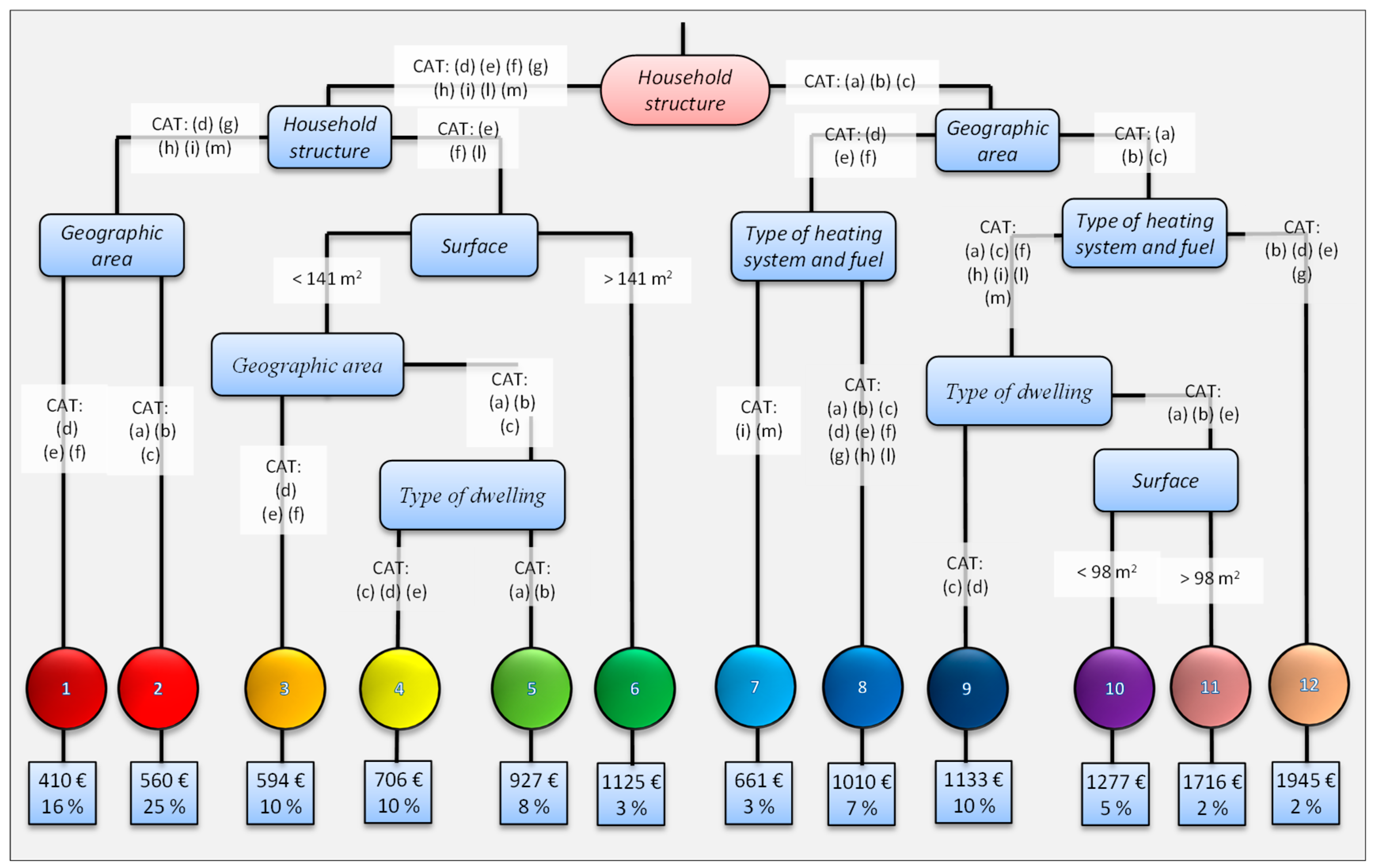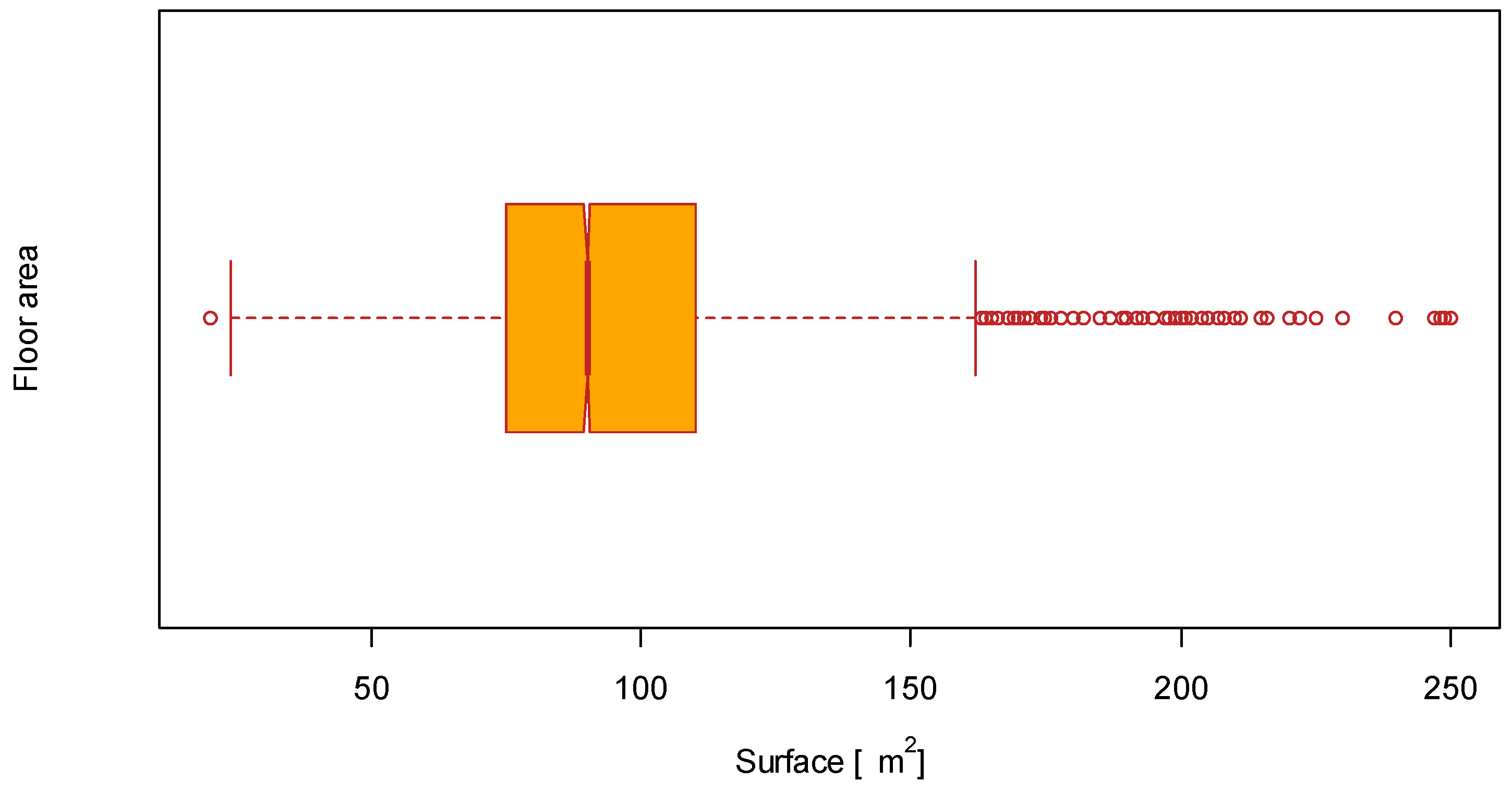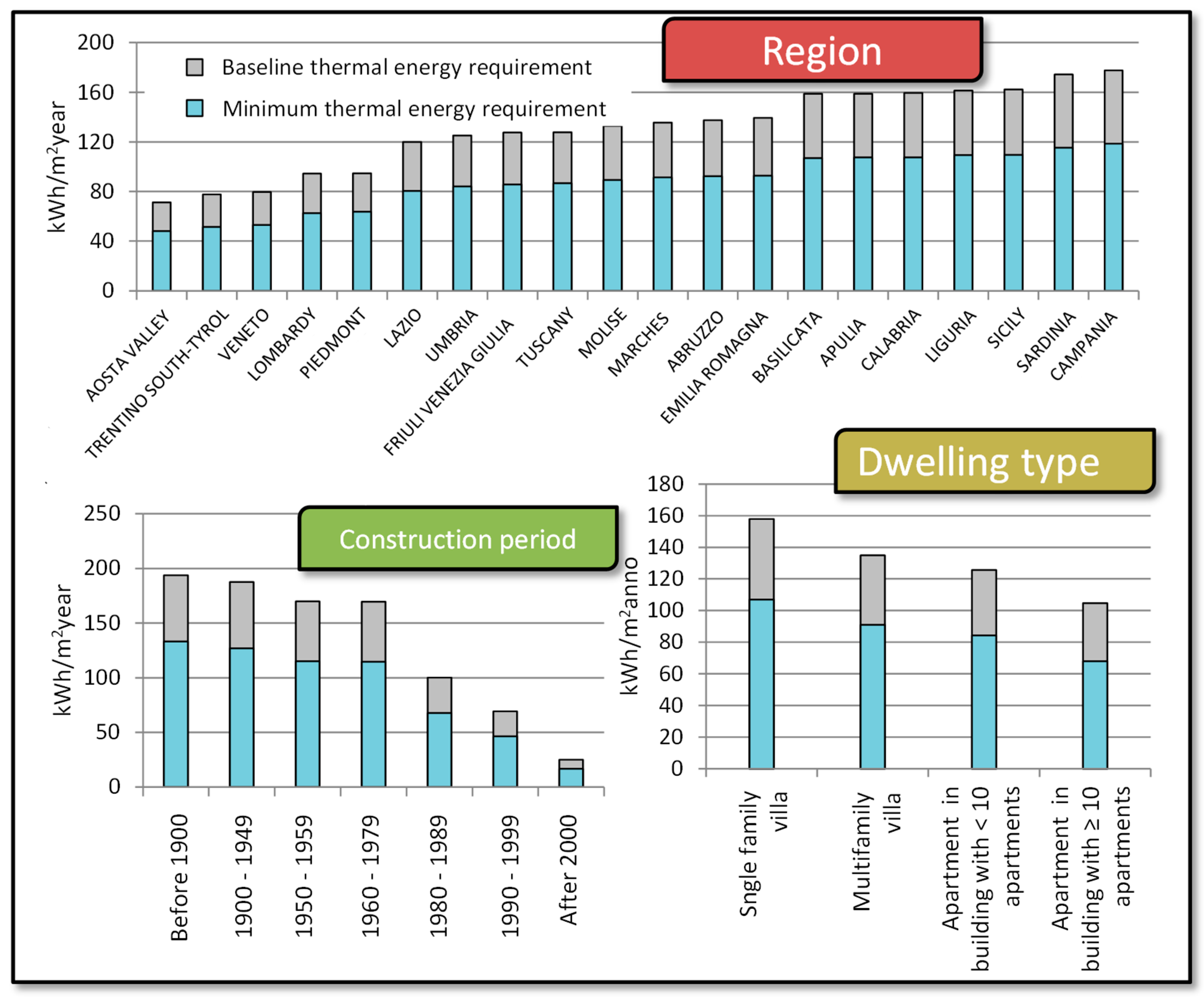Measuring Fuel Poverty in Italy: A Comparison between Different Indicators
Abstract
:1. Introduction
2. Research Design and Methods
2.1. Dataset and Household Segmentation
2.2. Measures of Fuel Poverty
- Criterion #1. Energy expenditure is lower than half of the median [26];
- Criterion #2. Incidence of energy expenditure on the total household expenditure is higher than double of the median [26];
- Criterion #3. Condition of absolute poverty: This criterion has been used as, in the dataset, no information concerning the income of the households is available to apply income-based criteria;
- Criterion #4. Energy expenditure is higher than double of the median [27];
- Criterion #5. Energy expenditure is higher, compared with food expenditure [27];
- Criterion #6. Household having scarce economic resources—this criterion has been used as, in the dataset, no information concerning the income of the households is available to apply income-based criteria;
- Criterion #7. Household having insufficient economic resources—this criterion has been used as, in the dataset, no information concerning the income of the households is available to apply income-based criteria; and
- Criterion #8. Households having thermal energy expenditure below the limit to reach a minimum comfort condition [21]. This indicator considers the thermal energy expenditure for heating purposes. The inclusion of the cooling load within fuel poverty definition has not been considered so far, to our knowledge, but would be a promising step forward with the respect to the present body of knowledge and an interesting point of view for future studies.
2.3. “Minimum Thermal Comfort Constraint” Criterion: Details and Implementation
2.3.1. Baseline Thermal Energy Requirement
- Climatic zone, classified based on the heating degree days (HDD), as reported in the Italian regulation [17] (Figure 3): (a) Zone “B” (600 < HDD ≤ 900); (b) zone “C” (900 < HDD ≤ 1400); (c) zone “D” (1400 < HDD ≤ 2100); (d) zone “E” (2100 < HDD ≤ 3000); and (e) zone “F” (HDD > 3000). Zone “A” (≤ 600 HDD) was not considered, as it is not representative [25]. The heating period, for the different climatic zones, and the number of hours when the heating system was turned on, are selected based on the current regulations in Italy [31].
- Dwelling type: (a) Single-family house (B1); (b) terraced house (B2); (c) multi-family house (B3); and (d) apartment block (B4).
- Construction period (see Figure 4): (a) Ante-1920 (V1), (b) 1921–1945 (V2), (c) 1946–1960 (V3), (d) 1961–1975 (V4), (e) 1976–1990 (V5), (f) 1991–2005 (V6), and (g) 2005–ongoing (V7);
- Geographic region: The geographic locations employed by Capozza et al. [29] concern the above-mentioned climatic zones; conversely, in the dataset, different Italian regions were used. As the climatic zones are based on HDDs, the annual baseline household heating requirement for the different regions (), were computed by a weighted average, based on the extension of the climatic bands inside the different regions. The extension of the climatic areas is approximated by counting the number of municipalities (nm), in each region, corresponding to the different climatic zones:where j is the j-climatic area and k is the k-region.
- Construction period: V1 is matched with “Before 1900”; V2 is matched with “Between 1900 and 1949”; V3 is matched with “Between 1950 and 1959”; V4 is matched with “Between 1960 and 1969” and “Between 1970 and 1979”; V5 is matched with “Between 1980 and 1989”; V6 is matched with “Between 1990 and 1999”; and V7 is matched with “Between 2000 and 2009” and “After 2009”.
- Dwelling type: B1 is matched with “Single family villa”; B2 is matched with “Multifamily villa”; B3 is matched with “Apartments in building with less than 10 apartments” and “other”; and B4 is matched with “Apartments in building with 10 or more apartments”.
2.3.2. Minimum Thermal Energy Requirement
- CC1: High comfort conditions → ;
- CC2: Normal comfort conditions → ; and
- CC3: Low comfort conditions → .
2.3.3. Minimum Thermal Energy Expenditure
2.3.4. Real Thermal Energy Expenditure
3. Results
- Criterion #1. Cluster #1 (39.7%), cluster #2 (21.2%), cluster #3 (16.2%), and cluster #7 (16.2%) contain a high percentage of households satisfying this criterion;
- Criterion #2. Cluster #12 (31.9%), cluster #10 (25.2%), cluster #8 (24.2%), and cluster #11 (22.1%) contain a high percentage of households satisfying this criterion;
- Criterion #3. Cluster #7 (10.1%), cluster #1 (8.2%) and cluster #3 (8.0%) contain a high percentage of household satisfying this criterion;
- Criterion #4. Cluster #12 (50.9%) and cluster #11 (45.1%) contain a high percentage of households satisfying this criterion;
- Criterion #5. Cluster #12 (22.6%), cluster #11 (17.0%), cluster #8 (10.7%) and cluster #10 (10.6%) contain a high percentage of households satisfying this criterion;
- Criterion #6. Cluster #7 (53.0%), cluster #8 (46.5%), cluster #3 (42.0%) and cluster #1 (40.9%) contain a high percentage of households satisfying this criterion;
- Criterion #7. Cluster #7 (18.2%), cluster #12 (11.1%), cluster #1 (10.6%) and cluster #3 (10.2%) contain a high percentage of households satisfying this criterion; and
- Criterion #8. Cluster #7 (44.7%), cluster #11 (11.1%) and cluster #6 (43.0%) and cluster#3 (41.5%) contain a high percentage of households satisfying this criterion.
4. Conclusions
Author Contributions
Funding
Conflicts of Interest
References
- Isherwood, R.M.; Hancock, B.C. Household Expenditure On fuel: Distributional Aspects; Economic Adviser’s OfficeDHSS: London, UK, 1979. [Google Scholar]
- Boardman, B. Fuel poverty: From Cold Homes to Affordable Warmth; Pinter Pub. Limited: London, UK, 1991. [Google Scholar]
- Li, K.; Lloyd, B.; Liang, X.J.; Wei, Y.M. Energy poor or fuel poor: What are the differences? Energy Policy 2014, 68, 476–481. [Google Scholar] [CrossRef]
- Liddell, C.M. Fuel poverty comes of age: Commemorating 21 years of research and policy. Energy Policy 2012, 49, 2–5. [Google Scholar] [CrossRef]
- Herrero, S.T. Energy poverty indicators: A critical review of methods. Indoor Built Environ. 2017, 26, 1018–1031. [Google Scholar] [CrossRef]
- Karásek, J.; Pojar, J. Programme to reduce energy poverty in the Czech Republic. Energy Policy 2018, 115, 131–137. [Google Scholar] [CrossRef]
- Castaño-Rosa, R.; Solís-Guzmán, J.; Rubio-Bellido, C.; Marrero, M. Towards a multiple-indicator approach to Energy Poverty in the European Union: A review. Energy Build. 2019, 193, 36–48. [Google Scholar] [CrossRef]
- European Observatory on Energy Poverty (EPOV). Available online: www.energypoverty.eu (accessed on 1 April 2019).
- Heindl, P. Measuring fuel poverty: General considerations and application to German household data. FinanzArchiv Public Financ. Anal. 2015, 71, 178–215. [Google Scholar] [CrossRef]
- Hills, J. Fuel Poverty: The Problem and Its Measurement—Interim Report of the Fuel Poverty Review; CASE Report; Deparment for Energy and Climate Change: London, UK, 2011.
- Moore, R. Definitions of fuel poverty: Implications for policy. Energy Policy 2012, 49, 19–26. [Google Scholar] [CrossRef]
- Bradshaw, J.; Middleton, S.; Davis, A.; Oldfield, N.; Smith, N.; Cusworth, L.; Williams, J. A Minimum Income Standard for Britain: What people Think; Joseph Rowntree Foundation: York, UK, 2008. [Google Scholar]
- Hills, J. Fuel Getting the Measure of Fuel Poverty. Final Report of the Fuel Poverty Review; CASE Report; Centre for the Analysis of Social Exclusion: London, UK, 2012. [Google Scholar]
- Preston, I.; White, V.; Blacklaws, K.; Hirsh, D. Fuel Poverty: Fuel and Poverty: A Rapid Evidence; CASE Report; Assessment for the Joseph Rowntree Foundation Centre for Sustainable Energy: Bristol, UK, 2014. [Google Scholar]
- Middlemiss, L. A critical analysis of the new politics of fuel poverty in England. Crit. Soc. Policy 2017, 37, 425–443. [Google Scholar] [CrossRef]
- Rademaekers, K.; Yearwood, J.; Ferreira, A.; Pye, S.; Ian Hamilton, P.; Agnolucci, D.G.; Karásek, J.; Anisimova, N. Selecting Indicators to Measure Energy Poverty Rotterdam; Framework Contract ENER/A4/516-2014; Trinomics: Rotterdam, The Netherlands, 2016. [Google Scholar]
- Romero, J.C.; Linares, P.; López Otero, X.; Labandeira, X.; Pérez Alonso, A. Energy Poverty in Spain, Economic Analysis and Proposals for Action; Economics for Energy: Madrid, Spain, 2015. [Google Scholar]
- Zhao, Q.R.; Chen, Q.H.; Xiao, Y.T.; Tian, G.Q.; Chu, X.L.; Liu, Q.M. Saving forests through development? Fuelwood consumption and the energy-ladder hypothesis in rural Southern China. Transform. Bus. Econ. 2017, 16, 199–219. [Google Scholar]
- Baležentis, T.; Štreimikienė, D.; Melnikienė, R.; Zeng, S.Z. Prospects of green growth in the electricity sector in Baltic States: Pinch analysis based on ecological footprint. Resour. Conserv. Recycl. 2019, 142, 37–48. [Google Scholar] [CrossRef]
- Zeng, S.Z.; Baležentis, T.; Streimikiene, D. Review of and Comparative Assessment of Energy Security in Baltic States. Renew. Sustain. Energy Rev. 2017, 76, 185–192. [Google Scholar] [CrossRef]
- Faiella, I.; Lavecchia, L.; Borgarello, M. Una Nuova Misura Della Povertà Energetica Delle Famiglie (A New Measure of Households’ Energy Poverty). Questioni di Economica e Finanza (Occasional Papers) 2017, 404, 1–16. [Google Scholar]
- Romero, J.C.; Linares, P.; López, X. The policy implications of energy poverty indicators. Energy Policy 2018, 115, 98–108. [Google Scholar] [CrossRef]
- Italian National Institute of Statistics (ISTAT). Household Budget Survey: Microdata for Research Purposes (Reference Year: 2015); ISTAT: Rome, Italy, 2017. [Google Scholar]
- Besagni, G.; Borgarello, M. The determinants of residential energy expenditure in Italy. Energy 2019, 165, 369–386. [Google Scholar] [CrossRef]
- Besagni, G.; Borgarello, M. The socio-demographic and geographical dimensions of fuel poverty in Italy. Energy Res. Soc. Sci. 2019, 49, 192–203. [Google Scholar] [CrossRef]
- EUROSTAT, 2010 Household Budget Survey. Available online: https://ec.europa.eu/eurostat/web/microdata/household-budget-survey (accessed on 1 April 2019).
- Ürge-Vorsatz, D.; Herrero, S.T. Building synergies between climate change mitigation and energy poverty alleviation. Energy Policy 2012, 49, 83–90. [Google Scholar] [CrossRef]
- UNI EN ISO 13790:2008. Prestazione energetica degli edifici—Calcolo del fabbisogno di energia per il riscaldamento e il raffrescamento. 2008. [Google Scholar]
- Capozza, A.; Carrara, F.; Gobbi, E.; Madonna, F.; Ravasio, F.; Panzeri, A. Analisi tecnico-economica di interventi di riqualificazione energetica del parco edilizio residenziale Italiano; RdS Report 14002104; RdS: Milan, Italy, 2013. [Google Scholar]
- Ballarini, I.; Corrado, V.; Madonna, F.; Paduos, S.; Ravasio, F. Energy refurbishment of the Italian residential building stock: Energy and cost analysis through the application of the building typology. Energy Policy 2017, 105, 148–160. [Google Scholar] [CrossRef]
- D.P.R. 16 aprile 2013, n 74. 2013. Regolamento recante norme per la progettazione, l’installazione, l’esercizio e la manutenzione degli impianti termici degli edifici ai fini del contenimento dei consumi di energia, in attuazione dell’art. 4, comma 4, della legge 9 gennaio 1991, Gazzetta Ufficiale della Repubblica Italiana. Available online: www.gazzettaufficiale.it/eli/id/2013/06/27/13G00114/sg (accessed on 1 April 2019).
- Madonna, F.; Corrado, V. Studio sulla riqualificazione energetica di edifici residenziali; RdS Report 14002701; RdS: Milan, Italy, 2014. [Google Scholar]
- Mazzarella, L. Dati climatici G. de Giorgio. In Proceedings of the Giornata di Studio Giovanni De Giorgio; Politecnico di Milano: Milan, Italy, 1997. [Google Scholar]
- Comité Européen de Normalisation. CEN Standard EN15251—Indoor Environmental Input Parameters for Design and Assessment of Energy Performance of Buildings—Addressing Indoor Air Quality, Thermal Environment, Lighting and Acoustics; Comité Européen de Normalisation: Brussels, Belgium, 2007. [Google Scholar]
- Madonna, F.; Quaglia, P. Riqualificazioni energetiche: Benefici di comfort e costi; Internal Report; Ricerca sul Sistema Energetico - RSE S.p.A.: Milan, Italy, 2016. [Google Scholar]
- Autorità di Regolazione per Energia Reti e Ambiente (ARERA). Available online: www.arera.it (accessed on 1 April 2019).







| Variable | Summary Statistics ** and Code Names for Figure 1 |
|---|---|
| Household structure * | (a) Single person 18–34 years (391), (b) Single person 35–64 years (1817), (c) Single person 65 years and more (2240), (d) Couple without children with HRP 18–34 years (178), (e) Couple without children with HRP 35-64 years (1350), (f) Couple without children with HRP 65 years and more (2164), (g) Couple with 1 child (2276), (h) Couple with 2 children (2184), (i) Couple with 3 children or more (495), (l) Mono parent family (1033), (m) Others (885) |
| Geographic location | (a) North-west (3284), (b) North-east (3382), (c) Centre (2791), (d) South (4385), (e) Sicily (753), (f) Sardinia (418) |
| Type of dwelling | (a) Single family villa (2738), (b) Multifamily villa (4587), (c) Apartments in building with less than 10 apartments (3733), (d) Apartments in building with 10 or more apartments (3939), (e) Other (16) |
| Floor area *** | Continuous variable [Mean = 98/Variance = 1342] |
| Cluster/Criterion. | #1 | #2 | #3 | #4 | #5 | #6 | #7 | #8 |
|---|---|---|---|---|---|---|---|---|
| 1 | 39.7 | 10.0 | 8.2 | 1.2 | 2.9 | 40.9 | 10.6 | 19.0 |
| 2 | 21.2 | 9.8 | 5.8 | 2.3 | 4.2 | 34.7 | 5.8 | 23.0 |
| 3 | 16.2 | 17.2 | 8.0 | 3.1 | 4.6 | 42.0 | 10.2 | 27.2 |
| 4 | 13.2 | 10.1 | 2.3 | 5.7 | 4.7 | 35.2 | 5.3 | 27.3 |
| 5 | 4.5 | 19.4 | 2.0 | 11.0 | 6.6 | 32.6 | 4.5 | 26.2 |
| 6 | 3.4 | 15.2 | 1.3 | 20.4 | 7.6 | 21.5 | 4.2 | 41.5 |
| 7 | 16.2 | 13.0 | 10.1 | 4.3 | 6.5 | 53.0 | 18.2 | 44.7 |
| 8 | 4.2 | 24.2 | 5.2 | 13.4 | 10.7 | 46.5 | 8.8 | 34.2 |
| 9 | 5.4 | 13.9 | 3.9 | 17.9 | 9.9 | 36.5 | 7.3 | 33.2 |
| 10 | 2.1 | 25.2 | 5.0 | 27.0 | 10.6 | 39.7 | 5.9 | 33.8 |
| 11 | 2.0 | 22.1 | 1.1 | 45.1 | 17.0 | 33.0 | 4.3 | 43.0 |
| 12 | 5.8 | 31.9 | 0.9 | 50.9 | 22.6 | 34.5 | 11.1 | 20.8 |
© 2019 by the authors. Licensee MDPI, Basel, Switzerland. This article is an open access article distributed under the terms and conditions of the Creative Commons Attribution (CC BY) license (http://creativecommons.org/licenses/by/4.0/).
Share and Cite
Besagni, G.; Borgarello, M. Measuring Fuel Poverty in Italy: A Comparison between Different Indicators. Sustainability 2019, 11, 2732. https://doi.org/10.3390/su11102732
Besagni G, Borgarello M. Measuring Fuel Poverty in Italy: A Comparison between Different Indicators. Sustainability. 2019; 11(10):2732. https://doi.org/10.3390/su11102732
Chicago/Turabian StyleBesagni, Giorgio, and Marco Borgarello. 2019. "Measuring Fuel Poverty in Italy: A Comparison between Different Indicators" Sustainability 11, no. 10: 2732. https://doi.org/10.3390/su11102732
APA StyleBesagni, G., & Borgarello, M. (2019). Measuring Fuel Poverty in Italy: A Comparison between Different Indicators. Sustainability, 11(10), 2732. https://doi.org/10.3390/su11102732






